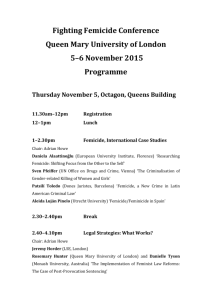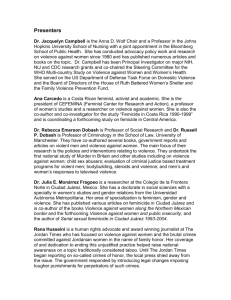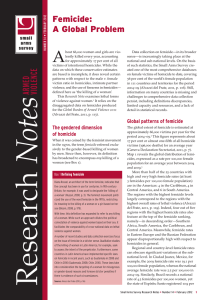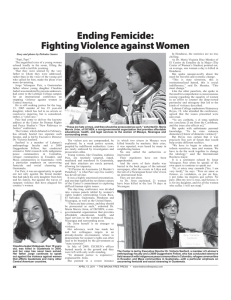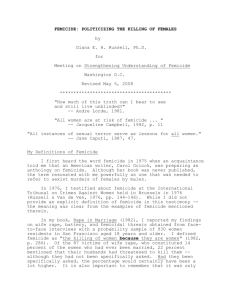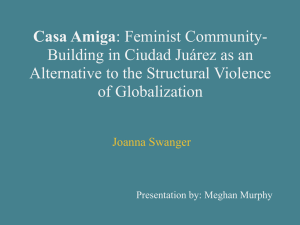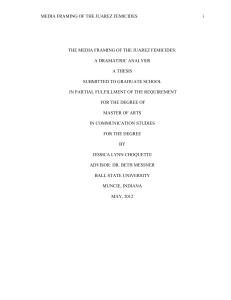Report on the Symposium on Femicide
advertisement
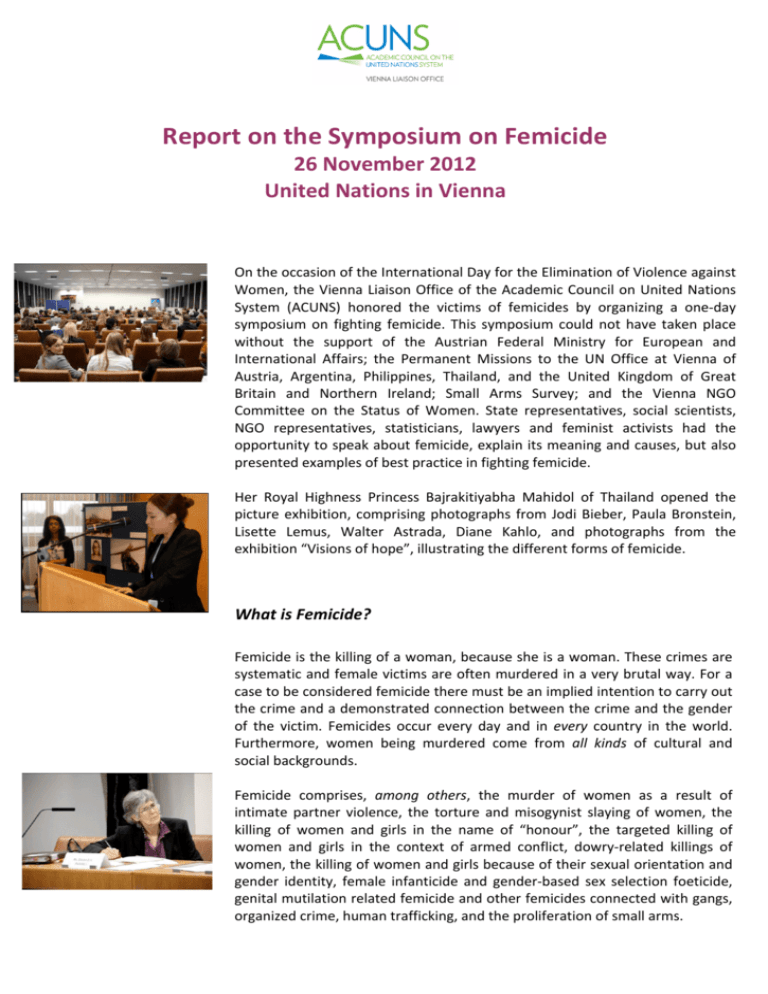
Report on the Symposium on Femicide 26 November 2012 United Nations in Vienna On the occasion of the International Day for the Elimination of Violence against Women, the Vienna Liaison Office of the Academic Council on United Nations System (ACUNS) honored the victims of femicides by organizing a one-­‐day symposium on fighting femicide. This symposium could not have taken place without the support of the Austrian Federal Ministry for European and International Affairs; the Permanent Missions to the UN Office at Vienna of Austria, Argentina, Philippines, Thailand, and the United Kingdom of Great Britain and Northern Ireland; Small Arms Survey; and the Vienna NGO Committee on the Status of Women. State representatives, social scientists, NGO representatives, statisticians, lawyers and feminist activists had the opportunity to speak about femicide, explain its meaning and causes, but also presented examples of best practice in fighting femicide. Her Royal Highness Princess Bajrakitiyabha Mahidol of Thailand opened the picture exhibition, comprising photographs from Jodi Bieber, Paula Bronstein, Lisette Lemus, Walter Astrada, Diane Kahlo, and photographs from the exhibition “Visions of hope”, illustrating the different forms of femicide. What is Femicide? Femicide is the killing of a woman, because she is a woman. These crimes are systematic and female victims are often murdered in a very brutal way. For a case to be considered femicide there must be an implied intention to carry out the crime and a demonstrated connection between the crime and the gender of the victim. Femicides occur every day and in every country in the world. Furthermore, women being murdered come from all kinds of cultural and social backgrounds. Femicide comprises, among others, the murder of women as a result of intimate partner violence, the torture and misogynist slaying of women, the killing of women and girls in the name of “honour”, the targeted killing of women and girls in the context of armed conflict, dowry-­‐related killings of women, the killing of women and girls because of their sexual orientation and gender identity, female infanticide and gender-­‐based sex selection foeticide, genital mutilation related femicide and other femicides connected with gangs, organized crime, human trafficking, and the proliferation of small arms. According to Prof. Diana Russell, who has dedicated her life to fighting femicide, sexism and misogyny are the main causes for the intentional killing of women. The Executive Director of UN Women, Michelle Bachelet, opened the symposium with a video message and expressed her support for this endeavor. UN Women recently intensified its efforts to tackle the issue of femicide and works closely with Special Rapporteur Rashida Manjoo, who delivered a report on femicide this May (2012). The Austrian Federal Minister for Women and the Civil Service Gabriele Heinisch-­‐Hosek reminded the audience that violence against women is also a reality in Austria and that unless there is no real equality between men and women, violence against women will prevail. The Deputy Executive Director of the United Nations Office on Drugs and Crime (UNODC), Sandeep Chawla, referred in his opening remarks to the UNODC Global Study on Homicide (2011). One of the findings of the report was that the home, which is supposed to be a safe haven, has now become the most dangerous place for women and girls. Indeed, in the European Union 70% of femicides result from intimate partner violence, i.e. that the woman was killed by her partner or former partner. Furthermore, 1 out of 4 women have experienced partner violence in their life and 7 women die every day as a result of domestic violence. In the United Kingdom, about two women per week are killed by their partner, and about 40% of the women murdered are victims of domestic conflicts. According to the Small Arms Survey Report 2012, presented by the Research Director of Small Arms Survey, Dr. Anna Alvazzi del Frate, studies have shown that guns inside the household, increase the risk of domestic disputes ending with a fatal outcome. One third of female victims of femicide were killed with firearms and many of them were previously threatened with it. The persons who commit femicides are often men, but women can also be the offenders. This can be the case when mothers kill their baby girls or intentionally abort their female foetus, when mothers or mother-­‐in-­‐laws are involved in honour killings or when girls die as a result of genital mutilation. However, many women commit these crimes because all their life they were told that they are less valuable than men. Mr. Sami Nevala, Team Coordinator for Statistics and Surveys at the European Union Agency for Fundamental Rights (FRA) and Ms. Angela Me, Chief Statistics and Surveys Section at the UNODC explained the difficulties in gathering and evaluating data on femicide. Ms. Me also mentioned that there is no such thing as 'global data on femicide' and that it is easier and more common to measure education, health, and the state of the economy. Although global studies on homicide contain chapters for women, this is by far not enough. Ms. Barbara Spinelli, Italian lawyer specialized on gender issues and leading force of the Italian platform “30 years CEDAW-­‐ Work in progress”, underlined that common indicators need to be established in order to collect internationally comparable data. Ms. Spinelli also insisted upon the states’ due diligence obligation to protect women as well as to prevent and prosecute femicide. Finally, Ms. Rita Banerji, who initiated the “50 Million Missing Campaign” in India, stressed that femicide is a human rights violation and that one of the main reasons why so many women are still being killed around the globe is impunity. Best practices As more and more countries have to respond to the increasing systematic killing of women in their territory, drawing attention to best practice examples during the symposium was of the utmost importance. Fortunately, many representatives of the UN member states have shown their interest to the topic and attended the symposium. H.E. Ambassador Susan le Jeune D’Allegeershecque, Permanent Representative of the United Kingdom of Great Britain and Northern Ireland to the United Nations and other International Organisations in Vienna, not only attended the symposium, but also shared best practices from the UK. For instance, in order to increase the number of perpetrators who are brought to justice, a specialist team of UK experts have come together to investigate and gather evidence. These teams include, but are not limited to police officers, lawyers, psychologist and forensic scientists. Preventing femicides and offering protection to women victim of gender-­‐based violence in war situations is also a top priority for the United Kingdom. H.E. Ambassador Dr. Christine Stix-­‐Hackl, Permanent Representative of Austria to the United Nations in Vienna, mentioned the Council of Europe Convention on “feminicides” which recognizes femicide as a global problem and will be useful in establishing new standards. She indicated Austria’s intention to sign the Convention in 2013, at the same time encouraging other states to do the same. H.E. Ambassador Lourdes O. Yparraguirre, Permanent Representative of the Philippines to the United Nations in Vienna, chaired the first session of the symposium and stressed again the importance of international cooperation between states, especially in sharing best practices. Ms. Maria Isabel Vicandi Plaza, Alternate Permanent Representative of Spain to the United Nations in Vienna, underlined that femicide should not be recognized as a crime of passion and that states must ensure the rights of women and fight violence against women. She stressed the lack of legal recognition of femicide in many countries and claimed that more investigation is needed. Spain has been a role model in the European Union in terms of successful awareness raising campaigns, but Latin American countries proved to be way ahead of many countries in the world in terms of successful legislation against femicide. Ms. Francisca Pérez Cotapos, a penal lawyer working for the Unit for the Prevention of Domestic Violence in Chile, gave concrete examples of the positive developments in Chile. In 2010, Article 390 of the Penal Code was added to the Chile legislation and since then, partners or former partners who murdered their female partner can be imprisoned because they committed a crime of femicide. More importantly, femicide is now not only part of the criminal law system, but also of the civil and family code of law. Ms. Cotapos stressed that using the word “femicide” in the legislation has made a crucial difference, as it distinguishes crimes against women. Since the introduction of this article, the number of femicides in Chile has decreased. In addition to legislation procedures, prevention and protection has been an important priority in Chile as well. Campaigns criminalizing violence against women and establishing special facilities for women, such as the 94 women’s centers and the 24 shelters, have also contributed to the decrease in femicides. The so-­‐called “Cross-­‐sector Protocol for Femicide Victims” also guarantees protection to victims on a legal, social and psychological level. Another important activity has been to educate men who battered their female partner. Dr. Ranjana Kumari, Director of the Center for Social Research in India, reported several positive developments in India. Since a law in 1984 made dowry killing an offence of harassment and non-­‐compoundable, there has been a consisting growth in the reporting system. Before the law was passed, police officers would tell the woman that the crime was her own fault. Under the new law, the police are obliged to act on a complaint and specific centers have been created for these complaints. A possible punishment for this crime, if it involves death, is life imprisonment. Judgment can, however, take up to nine years. Female selection/sex based selection is another major issue, not only in India but all over Asia. New technology that can detect the sex of the child before the birth has lead to numerous abortions of girls. Now, India has a good framework of law, but religion, society and tradition can be problematic. Although punishment for this crime is severe, not many cases have been brought to court. Public speeches, appearances in TV shows, radio broadcasting, campaigns and other awareness-­‐raising activities are important tools to end femicide as well. Ms. Gulcar Karademir presented the work of the International Free Women’s Federation, which has launched several campaigns to end femicide. Their aim is to let women and girls know their rights. Ms. Ilona Graenitz, Chairperson of the Vienna NGO Committee on the Status of Women, also stressed the importance of involving civil society, particularly more women’s organizations. Finally, for Prof. Diana Russell, International Tribunals on Crimes against Women which allow women to speak out and testify about crimes committed against them, could help raise awareness on this issue and could give women the courage to report. Professor Russell argued that femicide should be considered a form of genocide and that gender should be added to the Genocide Convention. Scientific research on femicide should also be encouraged, as it can identify the causes for gender-­‐based killings and develop tailored solutions. Ways forward The speakers of the symposium all agreed on one essential point: there is an institutional lack of awareness and political will to address the structural causes of femicide. The state’s obligation should be to prevent violence against women, protect victims of gender-­‐based violence and provide adequate investigation and prosecution. Furthermore, it is of the utmost importance that specific legislation targets gender-­‐based killings. Article 4 (c and d) of the UN Declaration on the Elimination of Violence against Women does require States to “exercise due diligence to prevent, investigate and in accordance with national legislation punish acts of violence against women whether those actions are perpetrated by the State or private persons.’, but, until now, the political will has not been strong enough for governments to fulfill these obligations. Dr. Eduardo Vetere, former Head of the UN Crime Prevention and Criminal Justice Programme, presented the Vienna Declaration on Femicide, a document that urges not only UN member states, but also UN organizations and civil society to join forces and take responsibility to put an end to femicide. The declaration was signed by the participants of the symposium as well as by Austria, Slovenia, the Philippines and Norway. ACUNS Vienna intends to bring the issue of femicide, together with the supporting states and partners of the symposium, to the 57th session of the Commission on the Status of Women which will take place in New York from 4-­‐15 March 2013 and will focus on the elimination and prevention of all forms of violence against women and girls. For more information or if you wish to sign the declaration please contact acuns.vienna.femicide@gmail.com
